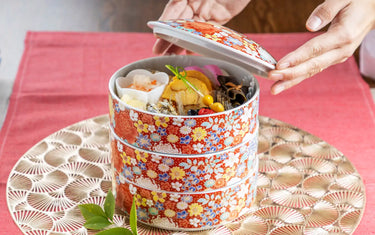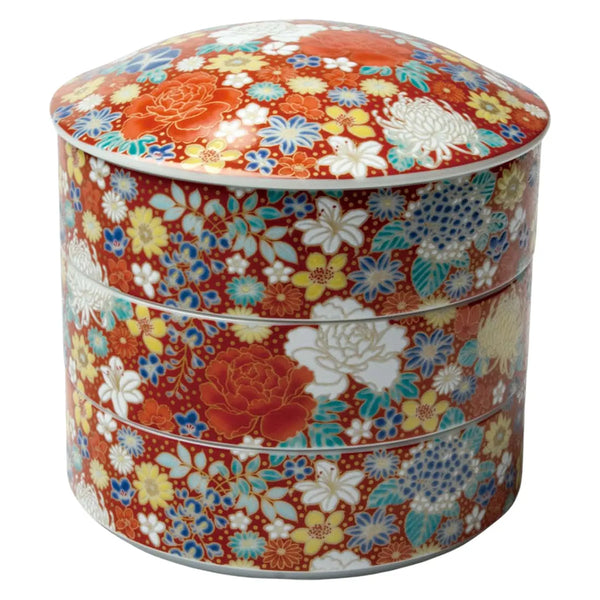The product we used:
What is Osechi?

Every year, Americans and other Westerners celebrate Christmas with a big family meal and then fall into an after-meal coma. Japanese typically don't celebrate Christmas, and if they do anything, they usually eat KFC fried chicken.
However, Japan does share a similar big-family-meal tradition at New Year's. At New Year's, families get together and each osechi--various foods presented in stacked containers called jubako.
Osechi has its origins in the Heian period (794–1185). During this time, people would offer food to the gods at Shinto shrines to express gratitude for the previous year and to pray for a prosperous and bountiful year ahead. This practice evolved into the preparation of special celebratory dishes that could be stored and consumed over the first few days of the New Year, a period when cooking was traditionally avoided.
Different osechi foods and their meanings.
Below is a list of the most common foods included in an osechi meal. This isn't a complete list--there are upwards of 30 different foods included in osechi across Japan depending on regional traditions.
Each food has a different meaning related to family, health, prosperity, and long-life. It's important to understand that Japan was an agricultural society when the tradition first began, so most of the foods are vegetables, and the meanings of some foods are influenced by agriculture.
Another thing to keep in mind is that the majority religion in Japan at the time was Shinto, and the tradition of osechi was originally Shinto, so the meanings of many of the foods are also influenced by Shinto beliefs.
Finally, some of these meanings rely on an understanding of Japanese (the Japanese have a love of wordplay in their blood, it seems).
Lotus Root

- Represents purity as lotus flowers bloom in the pure land's pond.
- The many holes symbolize a clear vision, praying for a transparent year.
Datemaki

- Is a kind of rolled omelette.
- Derives from "Datemaki," meaning stylish, good-looking, and flashy.
- Resembles a scroll, symbolizing academic success and cultural prosperity.
Chestnut Sweet

- Called “kuri kinton” in Japanese.
- The kanji for "kinto" turns into "kindan" (gold and silver treasures), evoking wealth.
Gomame-Tazukuri

- Based on using minced sardines as rice paddy fertilizer, symbolizing a bountiful harvest.
Taro Root

- Planting taro root seeds yields many offspring, symbolizing fertility.
Chikuzenni

- Various ingredients cooked together symbolize family unity and prosperity.
Burdock

- Strong roots in the soil symbolize a firm family foundation and the establishment of family business in the land.
- Also symbolizes having a long life.
- Used in another popular New Year's food, Ozoni
Shrimp

- The curved shape symbolizes longevity (like your bent-over 100 year old Japanese grandma), and the red color signifies good luck and protection from evil.
- The red body signifies good luck, and its beautiful red color is considered a talisman.
Red and White Kamaboko

- Kamaboko is like the fish version of a chicken nugget.
- The shape resembles a sunrise, considered suitable for the New Year.
- Red signifies warding off evil, and it also symbolizes joy, while white symbolizes purity.
Black Soybeans

- Symbolizes wishing for health and vitality.
- Specifically cooked to develop wrinkles, symbolizing a long and prosperous life.
Konnyaku with Tethers

- Tying the "tethers" tight symbolizes preparing the heart for challenges.
- The knots signify good relationships and a harmonious family.
Rolled Kelp

- Called “kombu” in Japanese. A wordplay with "yorokobu" (to rejoice).
- The character for "childbirth" on the Japanese kanji for kelp symbolizes wishing for children.
Herring Roe

- The numerous eggs represent the wish for descendants and fertility.
Turnip

- Chrysanthemum turnip represents prosperity and health. Also, it's associated with longevity and warding off evil.
Red and White Namasu

- The color scheme resembles celebratory wrapping strings, suggesting joyous occasions.
- Made with radish and carrot, with their deep roots, symbolizing building a strong family foundation.
Can't Prepare Your Own Osechi? No Problem (if you're in Japan).
If you're like me, you probably don't feel like your culinary skills are quite up to the challenge of preparing all of the different foods in osechi. Many people in Japan feel the same way. It's not uncommon for people to prepare some of the foods themselves and then buy the others pre-made.
However, if you plan on being in Japan at New Year's and you want to try osechi yourself, you can reserve a jubako of osechi from 7-11 or basically any other convenience store.
Otherwise, you'll need to ask your Japanese mother-in-law to make some for you.














